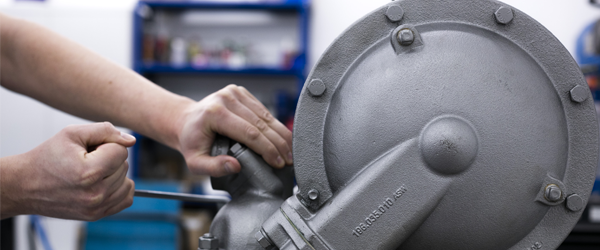According to data from Warren Rupp, the power cost to run compressors makes up almost 70% of the total cost of the compressed air system and 90% of most air compressor problems are located within the system itself. This is due to system layout, leaks, airline sizing, air treatment, piping materials and equipment specification. All of these issues reduce the run-time of compressed air systems so improving efficiency tends to be concentrated on the supply side. However, operators need to consider the demand side in order to ensure that equipment specifications are delivering efficient performance. By managing the compressed air demand of the pump to the application, considerable energy savings can be achieved. To this end, Warren Rupp has developed an air metering device, AirVantage that reduces the air consumption of its AODD 2 and 3-inch metallic pumps and which is being distributed throughout Europe by AxFlow Group.
Standard AODD pumps manage compressed air by means of a mechanical system typically consisting of a pilot valve mechanism that delivers a small flow of compressed air to actuate valves within the pump and engaging diaphragm movement. This reciprocating motion creates the pumping action. By design, AODD pumps change direction at the end of each stroke. The compressed air is supplied to the inner chamber until the pilot valve is actuated at the end of the stroke whereupon the main valve shifts and the compressed air is exhausted from the inner chamber at the same time as the opposite chamber is being pressurised. This end of stroke exhaust sequence creates the scenario where excess compressed air energy is being exhausted without doing any work before being released to atmosphere.
Self-powered by an internal generator that produces 12V AC, the AirVantage is available both as a complete pump and as a centre-section upgrade kit for existing installed pumps including both ball and flap valve construction. For intrinsically safe conditions, it is also available with an explosion-proof (ATEX certified) electrical assembly for operation in hazardous areas. The unit features an advanced learning programme that automatically adapts and controls the amount of air used under a variety of condition points, saving energy at the same time as maintaining a comparable flow.
AirVantage uses sensors to read pump velocity and switches the pilot valve during mid-stroke, allowing momentum or inertia to complete the pump stroke but without filling the diaphragm completely with air. This still moves fluid through the pump at comparable flow, but without consuming as much air. In operating mode, air enters the pump main inlet and a small amount of air is directed to a turbine which powers the unit. An air regulator controls the air volume with the air continuing on its standard path through the air system. The sensor placed in the centre section of the pump reads the pump velocity and communicates this information with a microchip that calculates the pump's ideal optimum point. This controls the amount of air that enters the diaphragm chambers, switching air to either side of the pump before the pump completes a stroke. As a result of employing a monitoring system that reads velocity, AirVantage can adapt as the pump's condition point changes from low discharge pressure to high discharge pressure, and allow more or less air to complete the stroke continuously optimising energy consumption.
Reducing the volume of compressed air used to drive the AODD pump will create other benefits for the user other than just contributing to energy savings. By operating more efficiently there is less wear on the compressed air systems and the pumps which lead to longer working life and reduced maintenance and improved plant productivity.
Håkan Bjernér, technical expert at AxFlow, comments the development: "In the past couple of years we have witnessed a clear trend in evaluation of the capital investments by the European process industry. Now the focus is on Total Life Cycle Costing (LCC). The deeper analysis of the LCC shows that energy costs usually exceed all other lifecycle costs. I am therefore very pleased with the AirVantage™. It gives us an opportunity to offer our customers efficient and more economical AODD pumps. Our own field tests have shown a reduction in air consumption of as much as 48%. The energy efficiency investments can therefore provide a significant boost to the overall productivity within the industry" added Håkan Bjernér.


